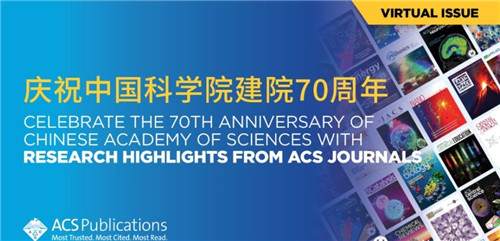The year 2019 marks the 70th founding anniversary of the Chinese Academy of Sciences (CAS). American Chemical Society (ACS) Publications has celebrated its 70th anniversary by highlighting 70 articles contributed by CAS researchers. Two articles conducted by the researchers at the Ningbo Institute of Materials Technology and Engineering (NIMTE), Chinese Academy of Sciences (CAS) have been successfully included in this special virtual issue, standing out from more than 14,000 CAS research articles in the last five years.
These two articles are “Vanillin-derived high-performance flame retardant epoxy resins: facile synthesis and properties”(Macromolecules, 2017, 50, 1892-1901)conducted by WANG Sheng, MA Songqi*, ZHU Jin*, et al., and “Simple and green fabrication of a superhydrophobic surface by one-step immersion for continuous oil/water separation”(The Journal of Physical Chemistry A, 2016, 120, 5617-5623)conducted by ZHU Jingfang, ZENG Zhixiang*, ZHAO Wenjie*, et al.
In the study entitled “Vanillin-derived high-performance flame retardant epoxy Resins: facile synthesis and properties”, researchers synthesized two novel bio-based epoxy monomers EP1 and EP2 by one-pot reaction of Schiff base formation and phosphorus-hydrogen addition between vanillin, diamines, and diethyl phosphite, followed by the reaction with epichlorohydrin. The reactivity of the bio-based epoxies was similar to DGEBA. After curing, they presented excellent flame retardancy with UL-94 V0 rating and high LOI of ~32.8%, thanks to the outstanding intumescent and dense char formation ability. Meanwhile, due to their high rigid structures, the cured vanillin-based epoxies had high Tg of ~214 °C, tensile strength of ~80.3 MPa, and tensile modulus of ~2709 MPa, much higher than those of the cured DGEBA. Additionally, the properties of vanillin-based epoxies were easy to regulate via different "coupling" agents diamines during the synthesis process. This study has shed light on the synthesis of high-performance flame retardant epoxy resins as well as the development of intumescent flame retardants (IFRs).
In the study entitled “Simple and green fabrication of a superhydrophobic surface by one-step immersion for continuous oil/water separation”, through one-step immersion in a solution containing hydrochloric acid and stearic acid,stainless steel mesh surfaces with uniform nanostructures and extremely low surface energy were fabricated. They presented superhydrophobic and superoleophilic properties. The contact angle (CA) test indicated that the mesh had a maximum apparent contact angle of 160 ± 1.0° and a sliding angle of less than 5.0° for the water droplet, whereas the apparent contact angle for the oil droplet was zero. Besides, the superhydrophobic and superoleophilic properties of mesh remained stable in ultrasonic oscillation, exposure tests at atmospheric conditions, and immersion corrosion tests in a 3.5 wt % NaCl aqueous solution. By virtue of the obtained mesh, researchers designed a miniature oil/water separation device pump to collect pure oil from the oil/water mixture easily and effectively. The techniques and materials presented in this study are promising for larger-scale fabrication as well as application in wastewater and oil spill treatment.
As a long-term partner of CAS, ACS was founded in 1876 and hailed as the world’s largest scientific society. ACS Publications is recognized as a leading publisher of authoritative scientific information. Massive high-quality articles that published in prestigious ACS journals are widely read and highly cited by worldwide researchers. ACS Publications has granted the public free access to CAS 70th Anniversary virtual Issue by the end of this year.

ACS Virtual Issue of CAS 70th Anniversary (Image by ACS)
Contact
HUANG Ye
Ningbo Institute of Materials Technology and Engineering
E-mail: huangye@nimte.ac.cn

